#bisticeratops
Explore tagged Tumblr posts
Text
Round Three: Changmiania vs Bisticeratops
Changmiania liaoningensis

Artwork by @i-draws-dinosaurs, written by @zygodactylus
Name Meaning: Eternal Sleeper from Liaoning
Time: 125.755 million years ago (Barremian stage of the Early Cretaceous)
Location: Lujiatun Beds, Yixian Formation, Liaoning, China
Changmiania is a gorgeously preserved ornithopod known from the earliest time of the famed Yixian Formation, adding it to the ranks of amazing fossils known from this unique preservational environment. The multiple specimens of this species are found in sleeping poses, curled up on the ground with their legs and arms tucked up against them. This indicates they had been buried alive, possibly inside their own burrows. Given the depositional environment of Yixian is a sort of prehistoric Pompeii, with many dinosaurs covered very quickly in ash and dust from an exploding volcano, this makes a certain degree of sense - perhaps the two little dinosaurs had scurried into their burrow to escape the oncoming tragedy (sorry if I just made you sad), or had been asleep and unaware of the oncoming danger. At only one meter long and less than half a meter tall, Changmiania would have been easily missed in its environment, hiding among the dense vegetation from potential predators. With robust leg bones, it would have been a fast runner, able to move efficiently through the crowded undergrowth. It had a weirdly short neck for ornithischians, and that combined with its short forearms and hands indicates it was fossorial - ie, a digging animal, hence its burrow home and final resting place. Given they were found together, they were probably social creatures as well, living in small family groups. The Yixian was a dense temperate forest, filled with freshwater lakes and a great diversity of plantlife. Conifers, ferns, cycads, horsetails, and early flowering plants filled the environment and indicated a humid, possibly rainforest environment. Periodic wildfires, noxious lake gasses, and volcanic eruptions all lead to regular moments of rapid burial and amazing preservation in this environment - essentially giving us snapshots of how it changed over the course of many millions of years. In the Lujiatun bed specifically, Changmiania was neighbors with Euhelopus, Jeholosaurus, Liaoceratops, Psittacosaurus, Liaoningornis, Daliansaurus, Graciliraptor, Mei, Sinovenator, Sinusonasus, Dilong, Hexing, Incisivosaurus, Shenzhousaurus, and outside of dinosaurs mammals such as Acristatherium, Gobiconodon, Juchilestes, Maotherium, Meemannodon, and Repenomamus (yes, THAT Repenomamus), and the toad Liaobatrachus.
Bisticeratops froeseorum
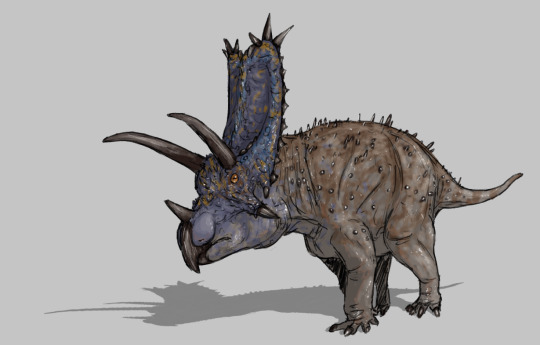
Artwork by sauriazoicillus, written by @zygodactylus
Name Meaning: Froese’s Dééł Náázíní Horned Face
Time: 74 million years ago (Campanian stage of the Late Cretaceous)
Location: Farmington Member, Kirtland Formation, New Mexico, United States
Bisticeratops is an early Chasmosaurine, known from a partial skull found in the Kirtland Formation. Yet another of a largely growing number of Chasmosaurine taxa from the Campanian of North America, it appeared to resemble Pentaceratops, but was more closely related to later ceratopsians known from the Kirtland formation, as well as one unnamed taxon from the Almond Formation in Wyoming. Interestingly, Bisticeratops shows signs of bite marks from tyrannosaurids, which apparently had begun to heal prior to death. However, we do not know which tyrannosaurid may have left these marks - while the Kirtland Formation is a well studied environment, the Farmington Member has never yielded dinosaurian fossils before now, taking place earlier than the more famous De-Na-Zin of the formation. Like other iterations, the Kirtland was a coastal plain along the western interior seaway, preserving a muddy and sandy environment that would have been filled with a variety of subtropical plants. It is presumable that other dinosaurs lived here besides Bisticeratops and a tyrannosaurid - hadrosaurs, ankylosaurs, pachycephalosaurs, ornithomimosaurs, and dromaeosaurs would all have been possible members of this ecosystem based on the following and preceding ones from this formation.
#dmm#dmm rising stars#dinosaur march madness#dinosaurs#birds#palaeoblr#birblr#bracket#polls#march madness#paleontology#changmiania#round three#bisticeratops
92 notes
·
View notes
Text
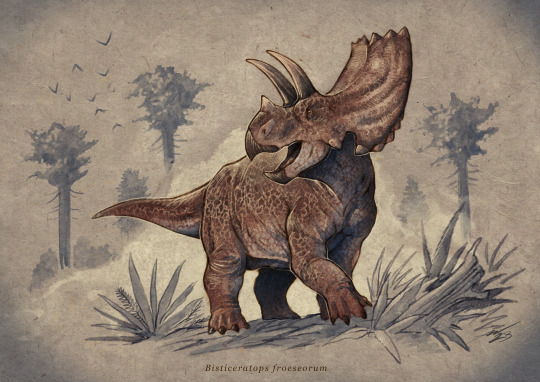
Day 14 - Bisticeratops, described in 2022 it’s a is a genus of chasmosaurine ceratopsians from the Late Cretaceous
#illustration#sketch#sketchbook#drawing#dinosaur#paleoart#dinosaurs#dinovember#dinovember2023#ceratopsian
165 notes
·
View notes
Text
Episode 28 - Control
Welcome to the Juras-Sick Park-Cast podcast, the Jurassic Park podcast about Michael Crichton's 1990 novel Jurassic Park, and also not about that, too.
Find the episode webpage at: Episode 28 - Control
In this episode, my terrific guest Dan Rose joins to us chat with me about:
The story of the velociraptors in the seminal dinosaur film Jurassic Park (1993) by Steven Spielberg, post-production duties, Sinking Ship Entertainment, foley artists, Dennis Nedry's death scene, dilophosaurus attacks, the specific moment when Jurassic Park goes from fun-loving to Friday the 13th, the Dino Dana Movie, working with dinosaurs, Robert Muldoon, the Big One, the raptors in Jurassic Park, the film raptors v. the book raptors, all the raptor scenes from the movie, a little bit of Girl Power, gender bending velociraptors, and way more!
Plus dinosaur news about:
A new chasmosaurinae ceratopsid from the upper Cretaceous Farmington member of the Kirtland Formation, New Mexico (Bisticeratops froeseorum)
Gnathovorax cabreirai: a new early dinosaur and the originand initial radiation of predatory dinosaurs (Gnathovorax cabreirai)
Featuring the music of Snale https://snalerock.bandcamp.com/releases
Intro: Grow Old or Don't. Outro: Centipede.
The Text:
This week’s text is Control, spanning from pages 138 - 143.
Synopsis:
Arnold and Hammond quarrel over the difficulties the park must overcome to have Jurassic Park ready for its grand opening, because they have all the problems of a major theme park, all the problems of a major zoo, and the added difficulties of caring for animals nobody’s ever observed before. It’s revealed that Dennis Nedry is here to fix the bugs in the system this weekend. On the tour, the guests visit the venomous dilophosaurus
Discussions surround:
Tension, Contrivances in the plot, Timeline, The Dinosaurs, Voice Acting, Park Management, Errors, and the Island's Layout.
Side effects:
May cause you to have trouble removing venomous sacs from anesthetized dilophosauruses.
Find it on iTunes, on Spotify (click here!) or on Podbean (click here).
Thank you!
The Jura-Sick Park-cast is a part of the Spring Chickens banner of amateur intellectual properties including the Spring Chickens funny pages, Tomb of the Undead graphic novel, the Second Lapse graphic novelettes, The Infantry, and the worst of it all, the King St. Capers.
You can find links to all that baggage in the show notes, or by visiting the schickens.blogpost.com or finding us on Facebook, at Facebook.com/SpringChickenCapers or me, I’m on twitter at @RogersRyan22 or email me at ryansrogers-at-gmail.com.
Thank you, dearly, for tuning in to the Juras-Sick Park-Cast, the Jurassic Park podcast where we talk about the novel Jurassic Park, and also not that, too. Until next time!
#JurassicPark #MichaelCrichton
#dinosaur movies#dinosaurs#jurassic park#michael crichton#youtube#dinosaur#podcast#velociraptor#dilophosaurus#Dennis Nedry#Robert Muldoon
1 note
·
View note
Text
Bisticeratops froeseorum Dalman et al., 2022 (new genus and species)

(Type skull of Bisticeratops froeseorum, from Dalman et al., 2022)
Meaning of name: Bisticeratops = Bisti/De-na-zin Wilderness Area horned face [in Greek]; froeseorum = for Edgar Froese [the late founder of the band Tangerine Dream] and Jerome Froese [former member of Tangerine Dream and founder of the band Loom]
Age: Late Cretaceous (Campanian), about 74 million years ago
Where found: Kirtland Formation, New Mexico, U.S.A.
How much is known: Nearly complete skull of one individual.
Notes: Bisticeratops was a chasmosaurine ceratopsian, making it a fairly close relative of Triceratops. The holotype skull of Bisticeratops was originally considered a specimen of Pentaceratops, another chasmosaurine from the Campanian of New Mexico. However, a new study identifies several distinguishing features that suggest it is a separate species. In addition, Bisticeratops is approximately 2 million years younger than Pentaceratops proper. Along with several other recently named ceratopsians, such as Sierraceratops, Navajoceratops, and Terminocavus, Bisticeratops shows that chasmosaurine diversity was very high in the Campanian of southwestern North America.
The Bisticeratops type specimen is also noteworthy in that it preserves multiple bite marks that were likely made by tyrannosaurids. One of these bite marks shows signs of healing, indicating that this individual had survived at least one attack from a predator.
Reference: Dalman, S.G., S.E. Jasinski, and S.G. Lucas. 2022. A new chasmosaurine ceratopsid from the Upper Cretaceous (Campanian) Farmington Member of the Kirtland Formation, New Mexico. New Mexico Museum of Natural History and Science Bulletin 90: 127–153.
88 notes
·
View notes
Text

Bisticeratops
Bisticeratops — рід хазмозавринових цератопсів із відслонень Киртландської формації кампанського періоду, знайдений в пустелі Бісті/Де-На-Зін на північному заході Нью-Мексико, США. Типовий і єдиний вид — B. froeseorum, відомий за майже повним черепом.
Повний текст на сайті "Вимерлий світ":
https://extinctworld.in.ua/bisticeratops/
#bisticeratops#ceratopsidae#paleoart#cretaceous#new mexico#usa#north america#cretaceous period#art#paleontology#animals#prehistoric#fossils#prehistory#science#illustration#daily#extinct#animal art#палеоарт#палеонтологія#тварини#США#крейда#мова#арт#українська мова#ukraine#ukrainian#україна
17 notes
·
View notes
Photo
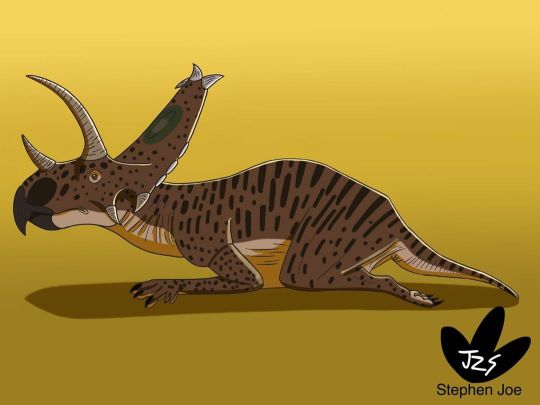
Bisticeratops froeseorum (or should I refer this one in Navajo word “Bisti’bidee’anii’”) is a newly described ceratopsid from Kirtland formation the latter of which is originated from Farmington member. #sketchbookapp #paleoart #artistsoninstagram #bisti #bisticeratops #bisticeratopsfroeseorum #ceratopsidae #chasmosaurinae #ceratopsia #ornithischia #dinosauria #dinosaur #myart https://www.instagram.com/p/ChaCv1fL1wM/?igshid=NGJjMDIxMWI=
#sketchbookapp#paleoart#artistsoninstagram#bisti#bisticeratops#bisticeratopsfroeseorum#ceratopsidae#chasmosaurinae#ceratopsia#ornithischia#dinosauria#dinosaur#myart
0 notes
Text
Scoperta una nuova specie di dinosauro cornuto
Scoperta una nuova specie di dinosauro cornuto
Ricostruzione in vita di Bisticeratops froeseorum. Un nuovo genere e una nuova specie di dinosauro ceratopside chasmosaurico è stato identificato da un cranio fossile conservato nei musei statunitensi per diversi decenni. L’esemplare era stato precedentemente classificato come appartenente a un altro genere di dinosauro ceratopside, Pentaceratops. La nuova specie di dinosauro apparteneva ai…

View On WordPress
0 notes
Text
Round Two: Bisticeratops vs Gobihadros
Bisticeratops froeseorum
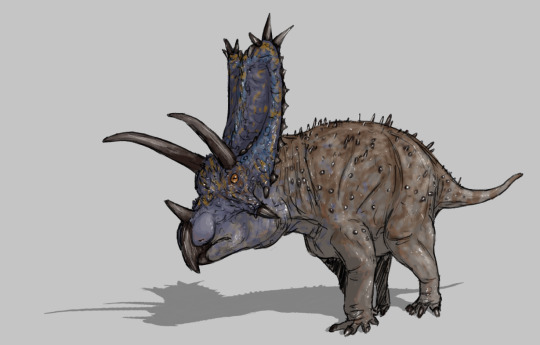
Artwork by sauriazoicillus, written by @zygodactylus
Name Meaning: Froese’s Dééł Náázíní Horned Face
Time: 74 million years ago (Campanian stage of the Late Cretaceous)
Location: Farmington Member, Kirtland Formation, New Mexico, United States
Bisticeratops is an early Chasmosaurine, known from a partial skull found in the Kirtland Formation. Yet another of a largely growing number of Chasmosaurine taxa from the Campanian of North America, it appeared to resemble Pentaceratops, but was more closely related to later ceratopsians known from the Kirtland formation, as well as one unnamed taxon from the Almond Formation in Wyoming. Interestingly, Bisticeratops shows signs of bite marks from tyrannosaurids, which apparently had begun to heal prior to death. However, we do not know which tyrannosaurid may have left these marks - while the Kirtland Formation is a well studied environment, the Farmington Member has never yielded dinosaurian fossils before now, taking place earlier than the more famous De-Na-Zin of the formation. Like other iterations, the Kirtland was a coastal plain along the western interior seaway, preserving a muddy and sandy environment that would have been filled with a variety of subtropical plants. It is presumable that other dinosaurs lived here besides Bisticeratops and a tyrannosaurid - hadrosaurs, ankylosaurs, pachycephalosaurs, ornithomimosaurs, and dromaeosaurs would all have been possible members of this ecosystem based on the following and preceding ones from this formation.
Gobihadros mongoliensis
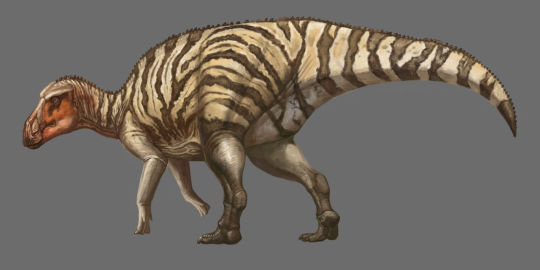
Artwork by KookaburraSurvivor, written by @zygodactylus
Name Meaning: Hadrosaur from the Gobi of Mongolia
Time: 90 to 86 million years ago (Turonian to Coniacian stages of the Late Cretaceous)
Location: Upper Beds, Bayan Shireh Formation, Bayshin Tsav, Baynshire, Char Teeg, Khongil Tsav, Khoorai Tsav, Mongolia
Gobihadros is an early almost-hadrosaur from the Bayan Shireh Formation, one of the rare environments preserving the evolution of dinosaurs during the start of the Late Cretaceous epoch - essentially, when the charismatic dinosaurs of the Latest Cretaceous, such as hadrosaurs, first evolved. Multiple specimens are known from throughout the formation, making Gobihadros the best known early hadrosauroid from Asia. Adults reached sizes of about 7.5 meters long, and it had as many as three teeth per position within the lower jaw (this is high even for early hadrosaurs, more similar to those of later taxa, indicating convergent/parallel evolution). It also still retained the conical thumb claw of earlier ornithopods like Iguanodon. An older individual of the species showed signs of calcium pyrophosphate deposition disease, a condition of age causing restriction in the joints and pain during movement. Gobihadros lived in a semi-arid plain environment littered with lakes and rivers, with meandering bodies of water draining into the sea on the coast of China. Flowering plants were present in this environment, as well as a wide variety of animal life - sharks, Azhdarchids, turtles, and other dinosaurs like Alectrosaurus (probably), a troodontid, Erlikosaurus, Caenagnathoids, Garudimimus, Graciliceratops, a possible Carcharodontosaur (which would be a late surviving species), Talarurus, and potentially many more species waiting to be formally named.
#dmm#dinosaur march madness#dinosaurs#birds#dmm rising stars#dmm round two#birblr#palaeoblr#paleontology#bracket#march madness#polls#bisticeratops#gobihadros
69 notes
·
View notes
Text
Bisticeratops vs Crittendenceratops


Factfiles:
Bisticeratops froeseorum

Artwork by sauriazoicillus, written by @zygodactylus
Name Meaning: Froese’s Dééł Náázíní Horned Face
Time: 74 million years ago (Campanian stage of the Late Cretaceous)
Location: Farmington Member, Kirtland Formation, New Mexico Bisticeratops is an early Chasmosaurine, known from a partial skull found in the Kirtland Formation. Yet another of a largely growing number of Chasmosaurine taxa from the Campanian of North America, it appeared to resemble Pentaceratops, but was more closely related to later ceratopsians known from the Kirtland formation, as well as one unnamed taxon from the Almond Formation in Wyoming. Interestingly, Bisticeratops shows signs of bite marks from tyrannosaurids, which apparently had begun to heal prior to death. However, we do not know which tyrannosaurid may have left these marks - while the Kirtland Formation is a well studied environment, the Farmington Member has never yielded dinosaurian fossils before now, taking place earlier than the more famous De-Na-Zin of the formation. Like other iterations, the Kirtland was a coastal plain along the western interior seaway, preserving a muddy and sandy environment that would have been filled with a variety of subtropical plants. It is presumable that other dinosaurs lived here besides Bisticeratops and a tyrannosaurid - hadrosaurs, ankylosaurs, pachycephalosaurs, ornithomimosaurs, and dromaeosaurs would all have been possible members of this ecosystem based on the following and preceding ones from this formation.
Crittendenceratops krzyzanowskii

Artwork by PaleoEquii, written by @zygodactylus
Name Meaning: Krzyzanowski’s Horned Face from Crittenden
Time: 73 million years ago (Campanian stage of the Late Cretaceous)
Location: Fort Crittenden Formation, Arizona Crittendenceratops is the first ever dinosaur named formally from the Fort Crittenden Formation, an alluvial plain filled with lakes and rivers and frequently shifting environments. This environment was very associated with water, with many types of gastropods and bivalves found in the ecosystem. Other dinosaurs have also been found here, but none have been named - including dromaeosaurids and a hadrosaurid. Amphibians, alligators, fish, and turtles also lived in this ecosystem. Crittendenceratops itself was a small Centrosaurine, only about 3.4 meters long, and it had small forward-curving hooks flanging off of the top of the frill, a thick nasal bone, and ridges on the back of the frill. It also had small curved horns above its eyes. It seemed to resemble Nasutaceratops, and appears to have been in a group with that and other similar Centrosaurines.
DMM Round One Masterpost
#dmm#dinosaur march madness#dmm round one#dmm rising stars#palaeoblr#dinosaurs#paleontology#bracket#march madness#polls#bisticeratops#crittendenceratops
84 notes
·
View notes
Text
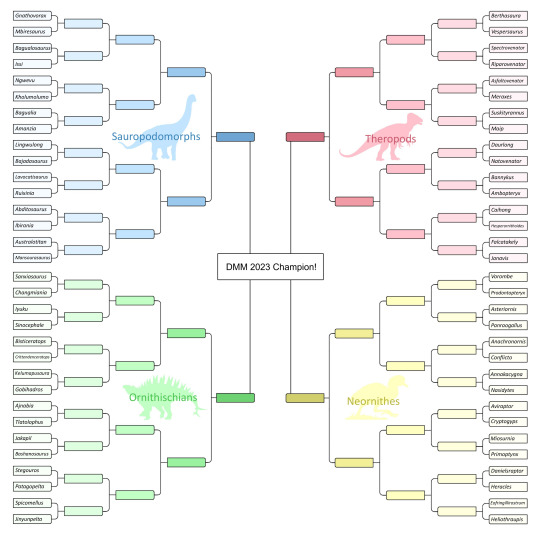
ITS TIME
FOR
DINOSAUR MARCH MADNESS 2k23!!!!!!!!!!!!
Starting NEXT WEEK, we begin the ultimate competition:
DMM: RISING STARS
These are ALL dinosaurs that have been discovered in the past five years!!! New friends from old times!!! Including such new fan favorites as Bajadasaurus, Jakapil, Meraxes, and Anachronornis - and that's only four of them!
From the weird to the wonderful, these dinosaurs are here to indicate that just because they were found recently, doesn't mean that they aren't destined to become icons like the names we already know and love. Get ready to learn about some new paleontological excitement - and debate angrily over which ones are better ;)
Round One will go from March 1st through the 7th
Round Two will extend from March 8th through the 14th
Round Three will then go from the 15th to the 21st
Round Four from the 22nd to the 28th
And the FINAL FOUR SHOWDOWN (Ornithischian Vs Sauropodomorph vs Nonavian theropod vs Bird) will occur from March 29th through April 4th!
Thanks to the new tumblr poll feature, reconstructions and mini factfiles for each dinosaur will be on the post with the poll itself! No need to leave tumblr, no personal research, no google quizzes - just rapid learning and immediate voting!
Get ready to vote! Get ready to debate! Get ready... for DINOSAUR MARCH MADNESS!
Round One Matchups under the readmore :)
SAUROPODOMORPHA (and miscellany)
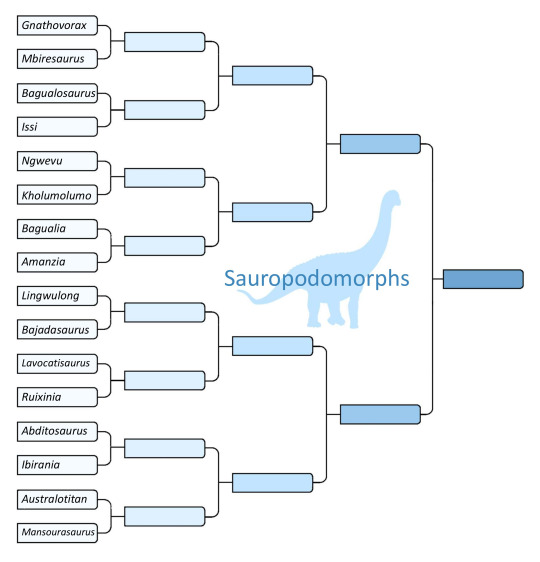
Gnathovorax vs Mbiresaurus Bagualosaurus vs Issi
Ngwevu vs Kholumolumo Bagualia vs Amanzia
Lingwulong vs Bajadasaurus Lavocatisaurus vs Ruixinia
Abditosaurus vs Ibirania Australotitan vs Mansourasaurus
ORNITHISCHIA
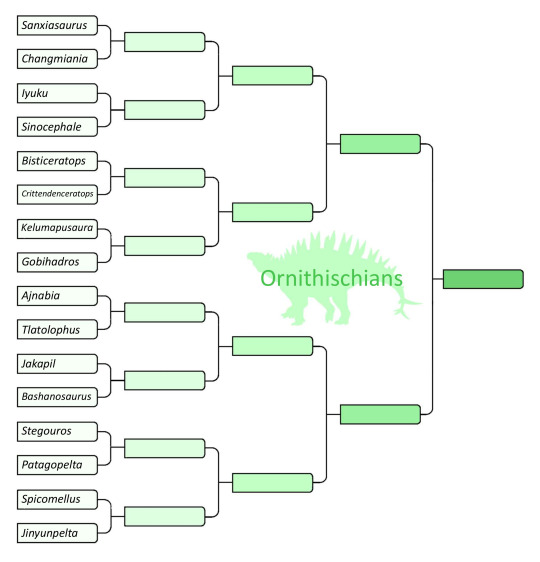
Sanxiasaurus vs Changmiania Iyuku vs Sinocephale
Bisticeratops vs Crittendenceratops Kelumapusaura vs Gobihadros
Ajnabia vs Tlatolophus Jakapil vs Bashanosaurus
Stegouros vs Patagopelta Spicomellus vs Jinyunpelta
NONAVIAN THEROPODA
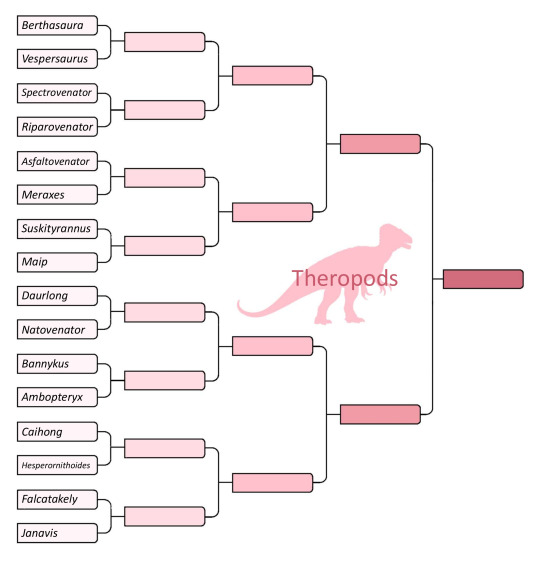
Berthasaura vs Vespersaurus Spectrovenator vs Riparovenator
Asfaltovenator vs Meraxes Suskityrannus vs Maip
Daurlong vs Natovenator Bannykus vs Ambopteryx
Caihong vs Hesperornithoides Falcatakely vs Janavis
NEORNITHES (BIRDS)
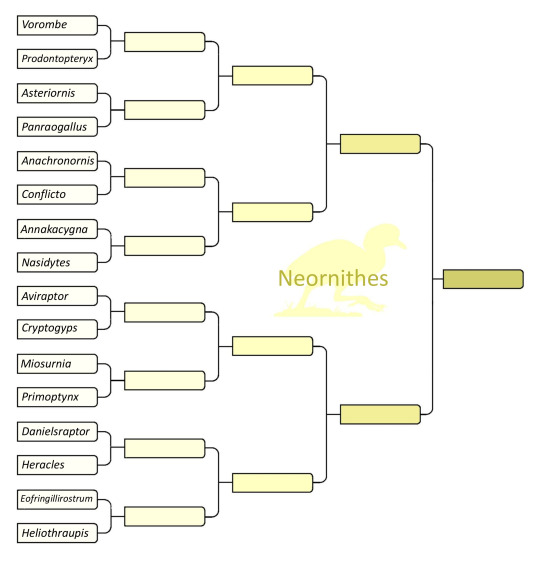
Vorombe vs Prodontopteryx Asteriornis vs Panraogallus
Anachronornis vs Conflicto Annakacygna vs Nasidytes
Aviraptor vs Cryptogyps Miosurnia vs Primoptynx
Danielsraptor vs Heracles Eofringillirostrum vs Heliothraupis
#dinosaur march madness#dmm#dmm rising stars#palaeoblr#dinosaurs#bracket#polls#march madness#tumblr dinosaur competition#thank you tumblr for making polls dmm is so much easier now I will cry#heliothraupis#eofringillirostrum#heracles#danielsraptor#primoptynx#miosurnia#cryptogyps#aviraptor#nasidytes#annakacygna#conflicto#anachronornis#panraogallus#asteriornis#prodontopteryx#vorombe#janavis#falcatakely#hesperornithoides#caihong
838 notes
·
View notes
Text
DMM ROUND TWO MASTERPOST
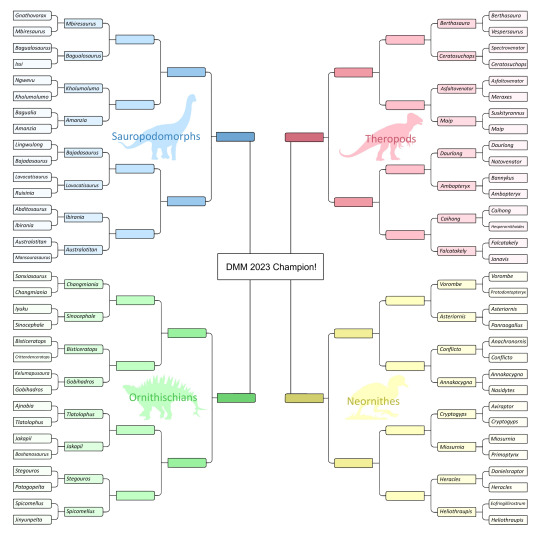
Ornithischians
Changmiania vs Sinocephale
Bisticeratops vs Gobihadros
Tlatolophus vs Jakapil
Stegouros vs Spicomellus
Sauropodomorphs
Mbiresaurus vs Bagualosaurus
Kholumalumo vs Amanzia
Bajadasaurus vs Lavocatisaurus
Ibirania vs Australotitan
Nonavian Theropods
Berthasaura vs Ceratosuchops
Asfaltovenator vs Maip
Daurlong vs Ambopteryx
Caihong vs Falcatakely
Avians (Neornithes)
Vorombe vs Asteriornis
Conflicto vs Annakacygna
Cryptogyps vs Miosurnia
Heracles vs Heliothraupis
REBLOG! SHARE! DEBATE!
IT'S DINOSAUR MARCH MADNESS!!!
#dmm#dinosaur march madness#dmm rising stars#dinosaurs#birds#dmm round two#dmm masterpost#paleontology#march madness#bracket#polls#birblr#palaeoblr
405 notes
·
View notes
Text
DMM ROUND THREE MASTER POST
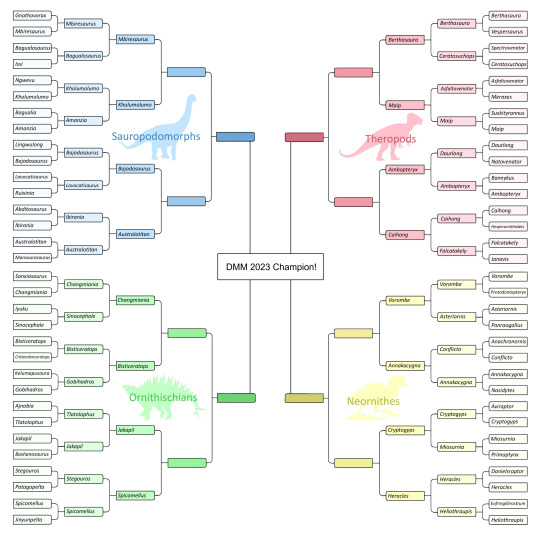
Ornithischians:
Changmiania vs Bisticeratops
Jakapil vs Spicomellus
Sauropodomorphs:
Mbiresaurus vs Kholumalumo
Bajadasaurus vs Australotitan
Non-neornithine Theropods:
Berthasaura vs Maip
Ambopteryx vs Caihong
Neornithes (Birds):
Vorombe vs Annakacygna
Cryptogyps vs Heracles
REBLOG! SHARE! DEBATE!
IT'S DINOSAUR MARCH MADNESS!!!
#dmm rising stars#dmm#dinosaur march madness#dinosaurs#birds#palaeoblr#birblr#paleontology#march madness#bracket#polls#round three
322 notes
·
View notes